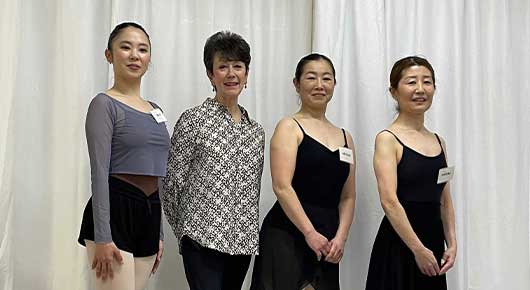1 October 2023

Small steps
Anne Raven Wilkinson was born in 1935 to a dentist father and a homemaker mother, growing up in a middle-class household in Harlem.
Ballet became a part of Raven’s life early on, when she was taken to a performance of Coppélia by the New York-based Ballet Russe de Monte Carlo at age five. Enthralled by the spectacle, Raven’s interest in dance had been sparked, and wanted to get involved immediately.
Her mother Anne James Wilkinson, who had previously been a ballet dancer back in Chicago, supported Raven’s newfound interest, taking her daughter to the School of American Ballet to seek lessons, but was rebuffed on the basis of Raven being too young at the time.
For her ninth birthday, Raven’s uncle gifted her the present of ballet lessons at the Swoboda Dance School. Ran by couple Maria and Vecheslav Swoboda, prestigious ballet dancers who had previously danced with the Moscow Bolshoi Theatre. Raven flourished in classes, and later took private lessons to progress her skills even further.

Progressing to pros
In 1954, the Swoboda School was bought by Serge Denham, the then director of the Ballet Russe de Monte Carlo, providing a direct link between Raven and a professional platform: one she hoped to capitalise on, as she hoped to make her passion her profession.
So began quite an arduous process for Wilkinson, wherein she was rebuffed multiple times by the Ballet Russes. Raven later heard from a friend who working in the administrative department that this was due to her race; the company regularly toured to the American south, where segregation was both alive and enforced.
This didn’t deter Raven, and on her third attempt she was admitted on a trial basis of six weeks. When this went well, she was officially admitted to the Ballet Russes de Monte Carlo later in 1955 at the age of 20, beginning a period of six years as a dancer for the company. In doing so, Raven Wilkinson became the first African American woman to hold a position in a major American dance company.
By her second season, Raven was promoted to a soloist, and began dancing prominent roles in the company’s productions – most notably her waltz solo in Les Sylphides, for which she garnered widespread acclaim.

Unfortunate opposition
Although Raven toured with the Ballet Russes at the beginning of her career with them, it quickly became clear that she wasn’t safe from discrimination, particularly when touring the segregated southern states.
She was requested by the company to use makeup intended for lighter skin tones, essentially masking her racial identity to avoid controversy, and was asked to not publicise her race in any form. Despite this request, Raven refused to hide her race - "I didn’t want to put the company in danger, but also never wanted to deny what I was. If someone questioned me directly, I couldn’t say, 'No, I’m not black.'".
This became relevant in 1957 during a tour stop in Atlanta, Georgie, where a hotel manager asked her race upon checking in with the rest of the Ballet Russes, and refused to let her stay. She was sent to a ‘coloured hotel’, humiliated but unwilling to compromise her identity.
In the city of Montgomery, Alabama on the same tour, the stage was stormed by members of the Ku Klux Klan, who demanded to know where Raven was. The situation was diffused quickly, but it became abundantly apparent the racial prejudices of the South made for a hostile work environment.
Upon returning from this particular tour, Raven stopped taking part in tours for the Ballet Russes, and in 1961, Raven made the difficult decision to leave the Ballet Russes de Monte Carlo, worn down by discrimination from within and without the company.

New horizons
After leaving the Balle Russes, Raven auditioned for several other American ensembles, including the New York City Ballet, American Ballet Theatre and the Metropolitan Opera Ballet, but was rejected from all of them. Disheartened and disillusioned from the world of dance, Raven began work at a department store, and upon leaving New York moved to an Anglican convent in Fond du Lac, Wisconsin, to pursue her lifelong spiritual interest.
After several months, a restless Raven found she missed dance, and decided her gift had not yet been used to the fullest. She returned to dance lessons, and shortly thereafter began seeking new professional placements.
After meeting Sylvester Campbell, an African American dancer who was part of the Dutch National Ballet, she was convinced to audition for the company, successfully joining in 1967 and travelling the world on tour with them, performing many notable parts.
In 1973, missing her home, Raven retired from dance and returned to America. The retirement didn’t last, as she joined the New York City Opera as part of their ballet ensemble, which marked her last dance position, which she held for 11 years. Upon her (proper) retirement from dance in 1985, her passion for performance continued, working with the New York City Opera as a character actor until the company’s dissolution in 2011.
Raven Wilkinson became an inspiration for many, though perhaps most notably for Misty Copeland, the first African American who became a principal dancer at the American Ballet Theatre, who has called her a mentor. Raven has since become the focus of documentaries, biographies and even the inspiration for a children’s book, even after passing away in 2018 at the age of 83.
Wilkinson didn’t set out to become a pioneer, but her love of dance and performance led her to unintentionally become one. Raven’s resilience and tenacity led her to challenge the status quo again and again, attaining international fame despite the setbacks pushed upon her - and forging a path for dancers she inspired to follow.









